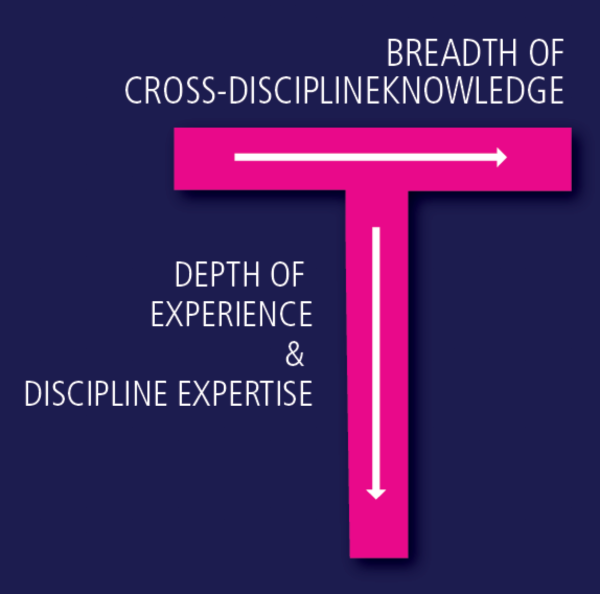The idea of the T-shaped individual first emerged in the early 1990s as a kind of ‘Renaissance Man’. When you hear the term that first name that pops up in one’s mind is that of Leonardo da Vinci. Da Vinci was definitely a T-shaped thinker; he was not only a brilliant artist, as we mostly know him, but an engineer, inventor, scientist, philosopher and much more. This is what probably honed his ability to look at the world with a different and exciting lens at the time. If anything, one can say he had diverse interests and that diversity helped shape him. Da Vinci’s ‘notebooks’ told a story of his adventures, trials, failures and successes; and spoke about his astonishing intellect and boundless curiosity for the world around him.
The whole idea of being a T-shaped thinker brings me to one of the most wonderful quotes by Jac Vanek
‘You are the books you read, the films you watch, the music you listen to, the people you meet, the dreams you have, and the conversations you engage in. You are what you take from these. You are the sound of the ocean, breath of the fresh air, the brightest light and the darkest corner. You are a collective of every experience you have had in your life. You are every single second of every day. So, drown yourself in a sea of knowledge and existence. Let the words run through your veins and the colours fill your mind until there is nothing left to do but explode. There are no wrong answers. Inspiration is everything. Sit back, relax, and take it all in.’
That’s really sums it all for us designers.
As opposed to being X-shaped or I-shaped thinkers’ designers are T-shaped thinkers and more than ever today they benefit from the same. A T-shaped thinker hence is someone that has a deep set of knowledge and expertise in their selected field but additionally they have the breadth of knowledge in other related and not directly connected aspects with a combination of a flexible mind set and a curious outlook.
I am always bringing up this concept in my classes with students and I am forever looking for ways to make students look at design, introspectively and otherwise. Whatever we do beyond acquiring the needed depth of skills makes us into who we are, the work we do and how we understand the world around us. This understanding is directly reciprocal to the ideas we generate the problems we solve and the concerns we identify.
There is this ongoing debate if designers should be ‘generalists or specialists’ and the answer, in my opinion, is neither.
As designers, we will and should have out depth of expertise in our field in regards to a grip of the visual language plus the needed skills that support it, but additionally to be able to do what we do and do it well and be effective, we need that breadth of knowledge and a broader world view. As a start, we need to be aware of what is happening in our fields in regions beyond our own. We need to be cognizant of the diachronic and synchronic facets of our field; what has happened historically but with finger on the pulse of the current zeitgeist. We designers need to be culturally conscious, politically aware. We need to be curious and open to serendipity, we need to be observant and exposed, we need to read and do so with understanding, question what we read, see and hear and in turn develop empathy, a valuable and unique a quality for designers.
Interestingly the trends to watch out for designers in 2012 talks about how seniority will be reinvented for designers in the future. Considering the influx of material and e-resource now readily and easily available to designers coming out in the market, the thing that will set the so-called senior designer apart will not be their skill set but their expertise and experience; their breadth of knowledge to support and balance the depth, that they have built on over the years.
So, then who are T-shaped thinkers?
- They are life-long learners; they make all situations and circumstances a learning experience
- They love collaboration. They are dot connectors and have the ability to build on ideas of others. They value the reciprocity of ideas.
- They are empathetic. Their natural curiosity, the ability to observe and reflect makes them into more empathetic individuals.
- They are analytical thinkers. They are abductive in their logic and driven by curiosity.
- They are problem solvers & identifiers. They think critically, rationally and backed with evidence.
Next: How can we build and nurture T-shaped thinkers?

